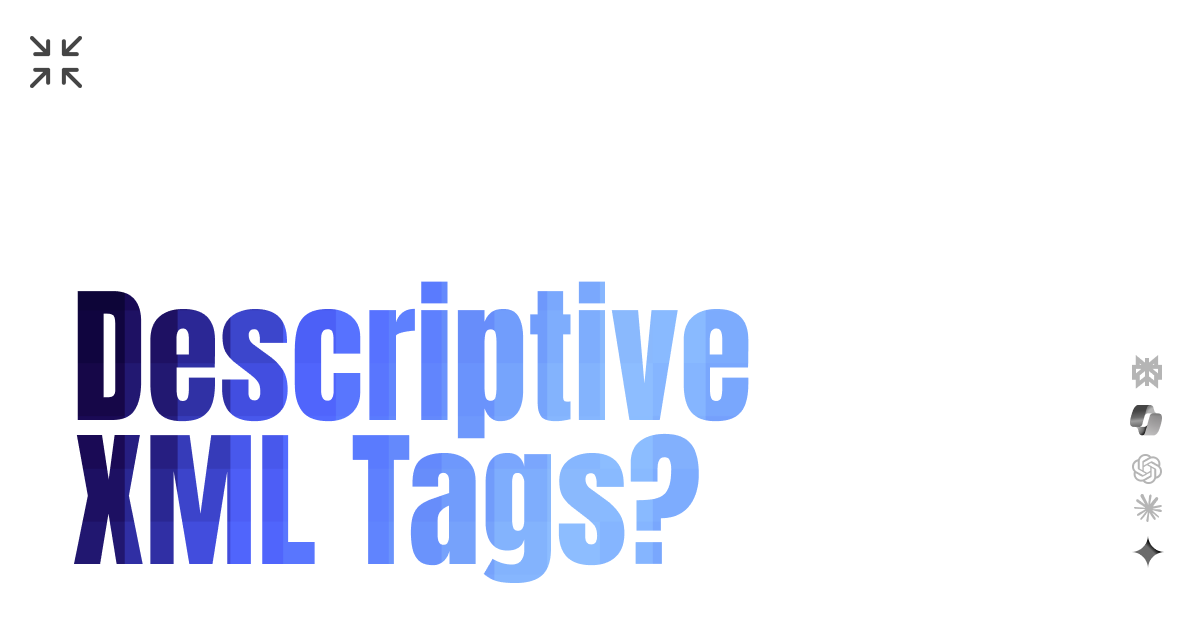Boost AI Prompt Performance with Descriptive XML Tags | LLM Prompt Engineering Guide
- 26 Jun, 2025


In the rapidly evolving world of Large Language Models (LLMs), effective prompt engineering is key to unlocking their full potential. One powerful technique that can improve AI response quality by up to 40% is the strategic use of descriptive XML tags. These custom-named tags go beyond generic identifiers, allowing you to clearly indicate the purpose and content of information within your AI prompts. By crafting meaningful tag names, you describe precisely what type of content is enclosed, dramatically enhancing an LLM’s understanding and leading to more accurate and reliable responses.
Descriptive XML tags are semantic markup elements that provide context and structure to your AI prompts. Unlike generic HTML tags, these custom tags are designed specifically to communicate intent and content type to language models like ChatGPT, Claude, and Gemini.
Quick Comparison: Before vs After ❌ Generic (less effective):
<input>Write a summary of this text</input>
<data>Lorem ipsum dolor sit amet...</data>✅ Descriptive (more effective):
<task_instruction>Write a summary of this text</task_instruction>
<source_document>Lorem ipsum dolor sit amet...</source_document>The difference? Semantic clarity that helps AI models understand not just what content they’re processing, but how to process it.
Research from prompt engineering experts shows that structured prompts with descriptive tags consistently outperform unstructured ones. Here’s why:
✅ Be Specific About Content Type
Generic TagDescriptive TagUse Case<data>``<financial_data>Stock prices, revenue figures<comments>``<user_feedback>Customer reviews, survey responses<specs>``<code_requirements>Software development tasks
✅ Indicate Function or Role
PurposeDescriptive TagExample ContentEvaluation standards<analysis_criteria>Focus on security and performanceFormatting<output_format>Provide bullet points with scoresBackground info<context_background>This is for a healthcare application
✅ Use Clear, Human-Readable Names
❌ Avoid✅ Use InsteadWhy better<cust_comp>``<customer_complaint>Immediately clear purpose<mt>``<meeting_transcript>No ambiguity about content<err>``<error_log_details>Specific about data type
For Content Analysis:
<document_to_analyze>
[Your document content here]
</document_to_analyze>
<analysis_focus>
Please focus on identifying key themes and sentiment
</analysis_focus>
<desired_output_format>
Provide results as bullet points with confidence scores
</desired_output_format>For Code Review:
<code_submission>
[Your code here]
</code_submission>
<review_criteria>
Focus on security vulnerabilities and performance issues
</review_criteria>
<experience_level>
Assume intermediate Python developer knowledge
</experience_level><email_analysis_task>
<email_content>
[Email text here]
</email_content>
<analysis_dimensions>
<tone_assessment>Formal, casual, or aggressive</tone_assessment>
<urgency_level>High, medium, or low priority</urgency_level>
<action_items>Extract any required actions</action_items>
</analysis_dimensions>
</email_analysis_task><market_research_task>
<research_scope>
<geographic_focus>North American SaaS market</geographic_focus>
<time_period>Q1 2024 to Q1 2025</time_period>
<company_size>Mid-market (100-1000 employees)</company_size>
</research_scope>
<analysis_requirements>
<competitive_landscape>Top 5 competitors with market share</competitive_landscape>
<pricing_analysis>Feature-to-price ratio comparison</pricing_analysis>
<growth_opportunities>Untapped market segments</growth_opportunities>
</analysis_requirements>
</market_research_task><content_moderation_task>
<user_generated_content>
[Social media post content here]
</user_generated_content>
<moderation_criteria>
<if_contains_profanity>Flag for human review</if_contains_profanity>
<if_spam_detected>Auto-remove and log</if_spam_detected>
<if_harassment_detected>Escalate immediately</if_harassment_detected>
</moderation_criteria>
</content_moderation_task><creative_brief_analysis>
<visual_elements>
<brand_colors>Blue (#1E3A8A), White (#FFFFFF)</brand_colors>
<logo_placement>Top-left corner, 120px width</logo_placement>
<imagery_style>Clean, minimalist, professional</imagery_style>
</visual_elements>
<copy_requirements>
<tone_of_voice>Confident but approachable</tone_of_voice>
<key_messages>Innovation, reliability, customer success</key_messages>
<call_to_action>Schedule a free consultation</call_to_action>
</copy_requirements>
</creative_brief_analysis>❌ Mistake 1: Vague Generic Tags
<!-- DON'T DO THIS -->
<input>Analyze this</input>
<data>Financial report content...</data>
<output>Make it good</output>❌ Mistake 2: Inconsistent Nesting
<!-- DON'T DO THIS -->
<analysis>
<criteria>Security focus
<code>function test() {}</code>
</criteria>
</analysis>❌ Mistake 3: Overly Complex Hierarchies
<!-- DON'T DO THIS -->
<main_task>
<sub_task_group_1>
<individual_task_item_a>
<specific_requirement_detail_1>
<micro_instruction>...</micro_instruction>
</specific_requirement_detail_1>
</individual_task_item_a>
</sub_task_group_1>
</main_task>✅ Best Practice Solutions
Advanced Tag Usage You can also nest tags for complex structures:
<email_analysis_task>
<email_content>
[Email text here]
</email_content>
<analysis_dimensions>
<tone_assessment>Formal, casual, or aggressive</tone_assessment>
<urgency_level>High, medium, or low priority</urgency_level>
<action_items>Extract any required actions</action_items>
</analysis_dimensions>
</email_analysis_task>Why Descriptive XML Tags Matter in Prompt Engineering for LLMs
In the world of AI prompt engineering, descriptive XML tags are a game-changer. Instead of using vague tags like or, replacing them with meaningful, human-readable tags such as <task_instruction>, <source_document>, or <output_format> brings semantic clarity to your prompts.
By clearly indicating the purpose and context of each prompt section, you provide large language models (LLMs) like Claude with structured guidance—which results in more accurate, consistent, and high-quality outputs.
Whether you’re crafting prompts for code reviews, content summarization, or email analysis, using well-structured XML tags helps the model “think” more effectively, without increasing prompt length.
✅ Why It Works Improves semantic understanding: Clear, purpose-driven tag names help LLMs interpret your intent.
🚀 Key Takeaway
✅** Next Steps:**
Ready to revolutionize your AI interactions? Start implementing descriptive XML tags today and experience the difference structured prompting can make.
Descriptive XML tags are custom markup elements used to clearly label sections of an AI prompt, improving how large language models interpret and respond.
Yes. Structured prompts using descriptive XML tags can increase LLM accuracy, reduce ambiguity, and improve reasoning by providing clear semantic context.
Absolutely. Both ChatGPT and Claude can parse well-structured descriptive XML tags, especially when used to clearly define tasks, inputs, and outputs.
Related Articles:
How to use XML tags.